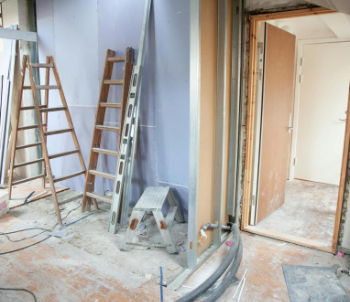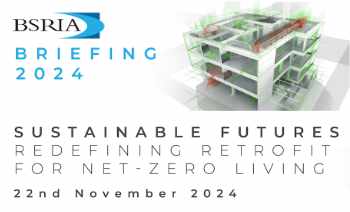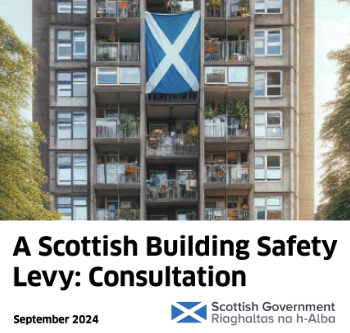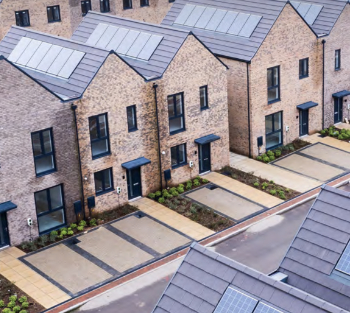Flat roof defects
Contents |
[edit] Introduction
Flat roofs were widely adopted in the UK after the Second World War. They were seen as a cheaper alternative to traditional pitched roofs, but whilst their capital cost can be lower, they can be prone to defects.
Whilst they are described as ‘flat’ almost all flat roofs are actually laid to a fall to ensure that rainwater can run off to the lower side. Typically they are designed to have a minimum fall of 1:40, which given on-site inaccuracies should result in a minimum fall of at least 1:80 in the finished construction.
The majority of flat roof problems relate to moisture, either from rainwater or condensation. In nearly every case of flat roof failure, the effect will be seen on the ceiling under the roof, but this does not mean that the fault is directly above the leak. By their very nature, flat roofs encourage water to spread across their surface seeking a weak point.
Common causes of failure include:
- If the design of the roof structure is inadequate, any sagging will result in rainwater being retained on the surface, where it has the potential to cause problems.
- If the supporting structure moves it has the potential to cause breaks in the roof covering, allowing water ingress.
- If the roof build up and ventilation does not make adequate provision for condensation, then moisture can build up within the structure.
- The roof covering itself can fail, as can the decking which supports the covering.
- Problems can occur at the perimeter of flat roofs, whether at parapets, verges or kerbs.
- Problems can occur where there are penetrations through the roof, such as vents pipes and ducts.
[edit] Concrete slab flat roofs
A concrete slab flat roof is normally made up of a structural layer finished with a smooth screed onto which a water proof layer such as a membrane is laid. The roof should incorporate insulation and usually a vapour control layer to protect from interstitial condensation.
It should also be remembered that there is a lot of water present in the concrete-making process. If insufficient drying time is allowed then any residual moisture may cause problems. Leaks can also occur in cold weather as a result of condensation, or due to rainwater penetration.
[edit] Timber flat roofs
Timber flat roof construction usually consists of structural joists topped with a decking of plywood or a similar sheet material. As with concrete flat roofs, a timber construction will be finished with a waterproof covering such as a membrane, or a sheet material such as lead. Insulation will be incorporated within the roof build up, together with a vapour control layer to protect from interstitial condensation.
Timber boards can shrink and warp causing damage to the waterproof layer above.
Water penetration and condensation problems are similar those found in to concrete roofs, although construction water will not be an issue as generally no wet trades are involved.
However, shrinkage problems can occur as the building itself dries out, and timber can absorb moisture and then deteriorate. Even treated timbers and decking can deteriorate if subject to moisture, which can cause rot and encourage mould growth. Any remedial work must address the issue of timber rot, either of the roof decking or of the structural timbers. Given the extent of the problem, timbers may have to be replaced, and remaining timbers treated, and the waterproof covering repaired.
If insulation has become wet, this may need to be replaced.
[edit] Flat roof coverings
Common flat roof coverings include:
- Sheet materials such as bituminous felt.
- In situ material materials such as asphalt.
- Metal such as lead or copper.
These roof coverings are generally designed to be laid flat and are prone to weakness where they are bent; for example, at skirtings, parapets and verges, and at joints or seams.
Problems can include:
- Movement of the covering or the underlying deck to which it is fixed.
- Deterioration of the material or its surface coating.
- Moisture retention.
- Poor detailing or workmanship.
- Damage caused by foot traffic or by maintenance activity.
[edit] Asphalt
Cracking of asphalt can be surface cracking or it can penetrate through the whole surface and expose the supporting layers. Surface cracking may be caused by shrinkage of the asphalt. If the cracks penetrate the surface it suggests movement or even failure of the structural elements of the roof.
[edit] Roofing felts
If properly laid, roofing felt should last for 20 years, but being a bituminous-based product it will suffer from long term exposure to sunlight. Ponding of water on the surface can also encourage a breakdown of the material especially at the edge of any pond.
Problems can occur if felt layers are not properly laid and bonded. Joints can negate the fall of the roof and encourage ponding. If water penetrates defective joints then adhesion between layers can deteriorate.
Problems can occur which are caused by the decking below the felt. Boards may have moved or warped, or interstitial condensation may build up between the gaps in the boards.
[edit] Lead
Defects are often caused by poor detailing at junctions, poor workmanship, and interstitial condensation. Lead is subjected to a wide temperature range and expands and contracts with changes in the weather, such as exposure to solar radiation. This can cause buckling and eventually cracking.
Problems can occur if lead is laid in sheets that are too big, or if the wrong thickness (code) of lead is used, or if junctions are not properly designed to cope with expansion. Where lead is welded, this may also cause failures.
While lead can withstand years of exposure to rainwater, condensation is distilled water which dissolves lead. This problem occurs in particular where lead has been laid over a ‘warm roof’ and forms on the underside of the sheet lead.
[edit] Zinc
Zinc is a cheaper alternative to lead, and is both lighter and thinner but not as durable.
It is susceptible to deterioration where it has been bent, but is more stable when subject to temperature change. Zinc becomes brittle with age, especially when exposed to a polluted atmosphere. This can make joints and seams susceptible to damage.
[edit] Copper
Copper is often selected as a roof covering for its appearance rather than for its longevity. It is susceptible to acid attack, such as acidic discharge from flues, bird droppings, etc.
For more information see Roofing defects.
[edit] Related articles on Designing Buildings Wiki
- Conical roof slating.
- Cool roofs.
- Defects.
- Domestic roofs.
- Failure of cast iron beams.
- Firring.
- Flashing.
- Flat roof.
- Green roofs.
- Inverted roof defect - case study.
- Latent defects.
- Long span roof.
- Patent defects.
- Remedial work.
- Roof insulation.
- Roof tiles.
- Roofing defects.
- Roofing repairs.
- Schedule of defects.
- Timber preservation.
- Shell roof
- Types of roof.
Featured articles and news
Considerate Constructors Scheme acquires Building A Safer Future
Acquisition defines a new era for safety in construction.
AT Awards evening 2024; the winners and finalists
Recognising professionals with outstanding achievements.
Reactions to the Autumn Budget announcement
And key elements of the quoted budget to rebuild Britain.
Chancellor of the Exchequer delivers Budget
Repairing, fixing, rebuilding, protecting and strengthening.
Expectation management in building design
Interest, management, occupant satisfaction and the performance gap.
Connecting conservation research and practice with IHBC
State of the art heritage research & practice and guidance.
Innovative Silica Safety Toolkit
Receives funding boost in memory of construction visionary.
Gentle density and the current context of planning changes
How should designers deliver it now as it appears in NPPF.
Sustainable Futures. Redefining Retrofit for Net Zero Living
More speakers confirmed for BSRIA Briefing 2024.
Making the most of urban land: Brownfield Passports
Policy paper in brief with industry responses welcomed.
The boundaries and networks of the Magonsæte.
London Build Fire and Security Expo
20-21 Nov and now with new Ambassador Programme..
The Scottish Building Safety Levy
Eight weeks of consultation closing on 18 November.
The grey, the brown and the golden rules of housing
shifting policies from the wild west of housing development.
Future proofing homes that are fit for purpose
Specification challenges and the role of plastic.
Thousands of new homes unlocked for brownfield sites
£68 million to 54 councils for neglected land into new homes.

























Comments
[edit] To make a comment about this article, or to suggest changes, click 'Add a comment' above. Separate your comments from any existing comments by inserting a horizontal line.